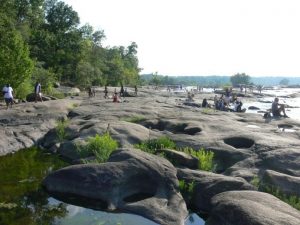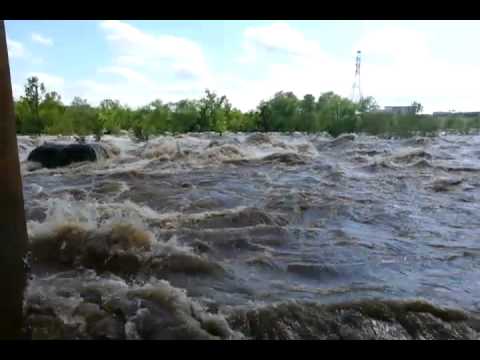As I bask on the large flat rocks of Belle Isle, I cannot help reminiscence about the majesty of the James. In front of me, the James roars powerfully as it negotiates bends around the edges of the flat rocks foaming lather, while swirling pebbles within the crevices of the large rock next to me. It’s mind-boggling to imagine that a simple process like swirling of
rocks within crevices will over a course of time result to formation of the magnificent potholes that characterize most of the flat rocks on this island. In a way, it seems like nature has conspired to produce phenomenal features from the simplest of processes, some of which may not be visible to us.
A few feet behind me, the scraped banks of the James are visible, as the river tries to alter its channel morphology. However, one thing stands out in particular- the human interference on the bank structure. A significant strip of the bank has either been reinforced using ripraps or concrete. For a moment, the idea of concrete banks seems
viable as an act aimed at taming bank erosion which has chiefly been responsible for increasing the amount of sediments in the James. However, with a little more critical approach I discern that concrete banks may result to more deleterious effects than we can imagine.
The sediments from bank erosion are critical in the creation of riparian habitats. The value of such riparian vegetation in controlling bank erosion and providing diverse ecological habitats along the James cannot be underestimated. Thus with engineered banks comes the danger of loss of these ecological functions. These bank-alterations tend to also increase the velocity of the river, increasing the rate of bank erosion downstream. This reduces the ability of floodplains to recharge and consequently exacerbates the water quality. Since watersheds are interlinked, it may be time before pollution from the James affects other watersheds like the Chesapeake or the Atlantic at large. This not only poses a huge threat for aquatic animals that depend on these systems but also on humans who draw water from such systems.
It may be time for us to address the real cause of increased sediments in the James which primarily arises during floods, rather than taming short term symptoms. A huge perk will definitely be controlling stormwater runoff and encouraging sustainable land use upstream of the James.
Second Visit:
Today the island looks very deserted compared to my first visit. Only a few people can be seen biking or jogging on the trail along the river. The magnificent, large, flat rocks that
characterize this island are hardly visible as the muddy James gushes past the fall line submerging everything on its bed. These are the results of a flood that hit a week ago escalating the river’s height to eight feet.
The muddy waters are a call for concern. Unsustainable agricultural practices upstream coupled with inefficient storm-water management from the residential and commercial areas within the watershed are primarily to blame for the current condition of the James. I am concerned that if nothing to mitigate these causes, we may be gradually regressing the James to its previous adulterated state.
I can hardly envisage the number of aquatic organisms that have faced the brunt of the muddy James. Sediments have been shown to cause detrimental effects on aquatic organisms by clogging gills of aquatic animals, thus destroying gill filaments necessary for breathing. This can lead to massive deaths of aquatic animals affecting population distributions. Moreover, the residents who depend on the James for water are not spared either. Water quality deteriorates significantly. Increased fecal matter from faulty sewer systems can pose a huge health threat during these floods.
As I leave my reflection spot, I am certain that a little community awareness can go along way to help the residents appraise their river and take action to preserve it. Ultimately, efficient storm-water management remains to be the most fundamental solution to this crisis.
References:
https://rotj.wordpress.com/tag/north-bank/
https://en.wikipedia.org/wiki/Belle_Isle_(Richmond,_Virginia)



